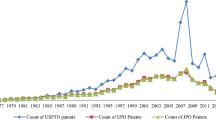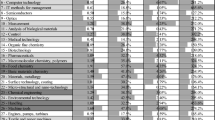Abstract
A frequently used indicator for assessing technological strengths of nations are patents registered in the triad region, i.e. in North America, Europe, and Asia. Currently these so-called triadic patents are defined as filed at the United States Patent and Trademark Office (USPTO), the European Patent Office (EPO), and the Japanese Patent Office (JPO). Recent developments suggested that this definition might lack adequacy regarding the offices in Europe and Asia. Our findings propose that in particular Germany and China should be added to this triad definition since in some technology fields patents registered in these countries show the same citation impact as patents registered at the EPO or JPO. Our results also underline that the number of triadic patent families per country is a function of technological specialization and (national) patenting strategies.
Similar content being viewed by others
References
Albert, M. B., Avery, D., Narin, F., Mcallister, P. (1991), Direct validation of citation counts as indicators of industrially important patents, Research Policy, 20: 251–259.
BMBF (2004), Bundesbericht Forschung 2004, Bundesministerium für Forschung und Technologie, Bonn.
Bacchiocchi, E., Montobbio, F. (2004), EPO vs USPTO Citation Lags, CESPRI Working Paper No. 161, ftp://ftp.unibocconi.it/pub/RePEc/cri/papers/WP161Montobbio.pdf (23-Aug-2005).
Basberg, B. L. (1987), Patents and the measurement of technological change: a survey of the literature, Research Policy, 16: 131–141.
Blind, K., Edler, J., Frietsch, R., Schmoch, U. (2003), Erfindungen kontra Patente: Schwerpunktstudie ‘zur technologischen Leistungsfähigkeit Deutschlands’: Endbericht, FhG-ISI, Karlsruhe.
Carpenter, M. P., Narin, F., Woolf, P. (1981), Citation rates to technologically important patents, World Patent Information, 3: 160–163.
DTI/OST, DTI/OST Technology Group & IPC Subclass Mapping, http://www.ipaustralia.gov.au/pdfs/statistics/Technology%20Groups.doc (June 27, 2006).
Dernis, H., Khan, M. (2004), Triadic patent families methodology, STI Working Paper 2004/2, OECD, http://www.oecd.org (15-Apr-2005).
Eaton, J., Kortum, S., Lerner, J. (2004), International Patenting and the European Patent Office: A Quantitative Assessment, Patents, Innovation, and Economic Performance: OECD Conference http://www.nber.org/CRIW/papers/eaton.pdf (Apr 16, 2007).
EPO (2002), Annual Report 2002, European Patent Office, München,. EPO European Patent Office Website, FAQ on Far East — China: Facts & Figures, http://patentinfo.european-patent-office.org/prod_serv/far_east/index.en.php (05-Jul-2006).
European Commission (2003), Third European Report on Science & Technology Indicators, Directorate-General for Research, Brussels.
Gehrke, B., Grupp, H. (1994), Innovationspotential und Hochtechnologie: technologische Position Deutschlands im internationalen Wettbewerb, Physica, Heidelberg.
Grupp, H., Schmoch, U. (1999), Patent statistics in the age of globalisation: new legal procedures, new analytical methods, new economic interpretation, Research Policy, 28: 377–396.
Grupp, H. (1998), Foundations of the Economics of Innovation: Theory, Measurement and Practice, Elgar, Cheltenham.
Hall, B. H., Jaffe, A. B., Trajtenberg, M. (2000), Market Value and Patent Citations: A First Look, NBER Working Paper No. 7741, Cambridge, Mass.
Legler, H., Gehrke, B. (2005), Zur technologischen Leistungsfähigkeit Deutschlands 2005, Bundesministerium für Bildung und Forschung, Berlin.
National Bureau of Statistics of China (2005), Chinese Statistical Yearbook.
Nunn, H., Oppenheim, C. (1980), A patent-journal citation network on prostaglandin, World Patent Information, 2: 57–60.
O’Keeffe, M. (2005), Cross comparison of US, EU, JP and Korean companies patenting activity in Japan and in the Peoples Republic of China, World Patent Information, 27: 125–134.
OECD (2005), Labour Force Statistics 1984–2004.
Rebel, D. (1993), Handbuch gewerbliche Schutzrechte: Übersichten und Strategien, Gabler, Wiesbaden.
Schmoch, U. & al., (1988), Technikprognosen mit Patentindikatoren: zur Einschätzung zukünftiger industrieller Entwicklungen bei Industrierobotern, Lasern, Solargeneratoren und immobilisierten Enzymen, TÜV Rheinland, Köln.
Schramm, R. (1995), Patentinformationen mittels Science Citation Index, Proceedings 17. DGD-Online-Tagung, Frankfurt, pp. 295–307.
Slama, J. (1981), Analysis by Means of a Gravitation Model of International Flows of Patent Applications in the Period 1967–1978, World Patent Information, 3: 2–8.
Täger, U. C. (1989), Probleme des deutschen Patentwesens im Hinblick auf die Innovationsaktivitäten der Wirtschaft: (insbesondere kleiner und mittlerer Unternehmen) und Vorschläge zu deren Lösung, Ifo-Inst. für Wirtschaftsforschung, München.
UNCTAD (2005), World Investment Report 2005, United Nations Conference on Trade and Development http://www.unctad.org/en/docs/wir2005_en.pdf (03-Jul-2006).
Watanabe, C., Tsuji, Y. S., Griffy-Brown, C. (2001), Patent statistics: deciphering a ‘real’ versus a ‘pseudo’ proxy of innovation, Technovation, 21: 783–790.
Yang, D. (2003), The development of intellectual property in China, World Patent Information, 25: 131–142.
Author information
Authors and Affiliations
Corresponding author
Rights and permissions
About this article
Cite this article
Sternitzke, C. Defining triadic patent families as a measure of technological strength. Scientometrics 81, 91–109 (2009). https://doi.org/10.1007/s11192-009-1836-6
Received:
Published:
Issue Date:
DOI: https://doi.org/10.1007/s11192-009-1836-6




